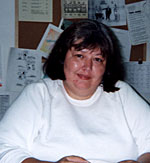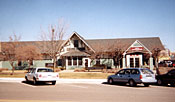
A Small Town Solution
by Bob Kelleher
April 2000
Grand Rapids is classic Minnesota. A small town of 8,000 smack in the
middle of state and national forests, and surrounded by hundreds of lakes.
In 1991, Grand Rapids was rocked by the violent abduction and murder of a
popular teenage girl. Carin Streufert's death spawned an
unprecedented movement in Grand Rapids: to identify the factors that might lead
a person to violence, and explore what could be done to stop it. What they
found is now being applied in small communities across Minnesota.
TOWNSPEOPLE WILL TELL YOU
that Grand Rapids is a wonderful place to raise kids. A
solid job base dominated by Blandin Corporation's massive paper mill; clean
living, and small-town values.
This was the home of Carin Streufert, a popular and pretty 18-year old, who was
grabbed off the darkened streets late on a warm summer night in 1991. For days,
townspeople searched for the missing girl. Within a week, two young men from the
area were under arrest. They were tried and convicted of murder.
First there was shock and then, fear.
"People started locking their doors that hadn't
locked their doors previously," says police chief Bill Litchke.
Sprawled on hard, plastic chairs in a small video-production room at the local
high school, four students agreed to talk about crime and violence and safety. And
most, like Junior Katie Halvorson, feel pretty safe in Grand Rapids.
"I take my dog for a walk every night," she says. "In Minneapolis, I
wouldn't walk alone at night."
Senior Jake Lundquist remembers peace fairs and marches when the community
responded to Streufert's death. His grade school launched a new curriculum to
teach students to handle conflict. Jake is skeptical about the permanence of
the message the community's given its kids.
 |
 |

|
Experts found a pattern
of troubling behaviors, like domestic violence and child abuse in Grand Rapids.
Karen Brady, program coordinator for Women's Rural Advocacy Program, provides tips for battered women. Listen (RealAudio 28.8) For additional information, see the WRAP Web site.
Photo: Cara Hetland
|
|
 |
| |
Despite the signals to the contrary,
Katie Halverson says the risk of crime in Grand Rapids is low. "My parents even wouldn't even let me go out on Halloween, after Carin Streufert's murder," she says. "But now it's all fading away again. It's Grand
Rapids. It's a safe little town."
Nine years may be too soon to measure success. Ask a handful of adults how the
town's changed, and you get another handful of views.
"I think that people are more aware; I think they do not walk
alone at night; I think they lock their doors a little more," says Barbara Sanderson.
That doesn't make Grand Rapids unusual. A Minnesota Public Radio poll on crime
attitudes finds a vast majority of rural Minnesotans feel safe in their homes
and neighborhoods. But most now lock their homes and cars.
Small towns were supposed to be immune from big city crime; separated by
distance and culture. Carin Streufert's death wasn't urban crime bleeding
into rural Minnesota, however. It was a random attack by two young men who people knew.
Residents realized Grand Rapids was no island from crime and violence. They
wanted to know why.
Neighbor Barb Sanderson remembers the meetings that began not long after
Carin's death. A a loose collection of residents called itself "The
Community Peace and Safety Group." Their first goal was an examination of the
problems and services available in the area. A two-year study of rural violence
challenged the myth of small-town values. Alcohol and drug abuse were rampant.
Acts of violence - like domestic abuse - were rarely reported or prosecuted.
"Our community had a great deal of the
factors that made us very much at risk for violent behavior," Sanderson says. "Lack of opportunities for earned income, high substance abuse, unsafe living conditions
for a great many people, lack of social support systems and lack of community
connectiveness."
Itasca County ranked highest in the state in one measure of physical violence in
the home, third in the rate of births to teenage mothers, and fourth in a
ranking of alcohol problems in the family. They found in Grand Rapids, a pattern
of troubling behaviors, like domestic violence and child abuse. And they
uncovered structural problems. Police, prosecutors, social workers and schools
hadn't been talking enough to each other.
With the study in hand, group members approached regional
resource centers - schools, churches, courts, and social services - to set the
community on a change of course.
Enthusiasm has its limits. Over the years, the pain and shock of Carin's death
subsided. Eventually, the Streufert family left Grand Rapids for Duluth, where, they wouldn't have to be known as the parents who
lost a child to crime.
"The Community Peace Initiative, up until the Streuferts left here, was
really active," recalls Police Chief Litchke. "Out of that we had some community meetings, we had a peace walk every year, just calling attention this that kind of stuff. Now the last year-and-a-half or so, that's kind of dropped by the wayside, but I can see it's
going to come back around."
The most promising work continues on a daily basis in small communities
across the state.
The Citizen's Council on Crime and Justice has taken Grand Rapids' community
approach statewide. The council hopes to stem the
factors that might fuel criminal behavior in 25 Minnesota communities
over a five-year period.
To keep an ambitious effort like this alive takes more than dedicated
individuals, according to Jim Krile, who directs the Blandin Foundation's
Community Leadership Program. Krile says it takes institutions like schools,
government, or a foundation like Blandin, with a structure and a budget.
He says peace isn't in retreat in Grand Rapids, it's just less visible.
There is a small memorial plaque to remember Carin Streufert, and a community
fund in Grand Rapids that supports anti-violence work. But her legacy is most
alive in communities across the state, as people work to make sure that young
girls can walk on warm summer nights without fear.

![]()
![]()
![]()

![]()
![]()
![]()

![]()
